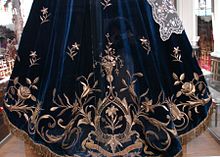
Embroidery is the art of decorating fabric or other materials using a needle to stitch thread or yarn. Embroidery may also incorporate other materials such as pearls, beads, quills, and sequins. In modern days, embroidery is usually seen on caps, hats, coats, overlays, blankets, dress shirts, denim, dresses, stockings, scarfs, shoes, handbags and golf shirts. Embroidery is available in a wide variety of thread or yarn colour. It is often used to personalize gifts or clothing items.

Crewel embroidery, or crewelwork, is a type of surface embroidery using wool. A wide variety of different embroidery stitches are used to follow a design outline applied to the fabric. The technique is at least a thousand years old.

Korean embroidery techniques and artifacts have a long history, but there is the most evidence from the Joseon Dynasty, after the 14th century in Korea. This article talks about the history, styles, preservation, artists, and examples of screens, costumes, and domestic wares of this exacting and beautiful art form.

Armenian needlelace is a pure form of needle lace made using only a needle, thread and pair of scissors.
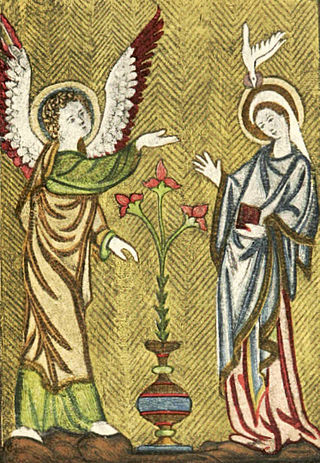
Opus Anglicanum or English work is fine needlework of Medieval England done for ecclesiastical or secular use on clothing, hangings or other textiles, often using gold and silver threads on rich velvet or linen grounds. Such English embroidery was in great demand across Europe, particularly from the late 12th to mid-14th centuries and was a luxury product often used for diplomatic gifts.

Whitework embroidery is any embroidery technique in which the stitching is the same color as the foundation fabric. Styles of whitework embroidery include most drawn thread work, broderie anglaise, Hardanger embroidery, Hedebo embroidery, Mountmellick embroidery, reticella and Schwalm. Whitework embroidery is one of the techniques employed in heirloom sewing for blouses, christening gowns, baby bonnets, and other small articles.
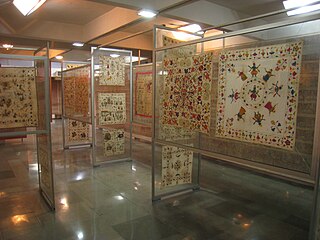
Embroidery in India includes dozens of embroidery styles that vary by region and clothing styles. Designs in Indian embroidery are formed on the basis of the texture and the design of the fabric and the stitch. The dot and the alternate dot, the circle, the square, the triangle, and permutations and combinations of these constitute the design.

Cloth of gold or gold cloth is a fabric woven with a gold-wrapped or spun weft—referred to as "a spirally spun gold strip". In most cases, the core yarn is silk, wrapped (filé) with a band or strip of high content gold. In rarer instances, fine linen and wool have been used as the core.
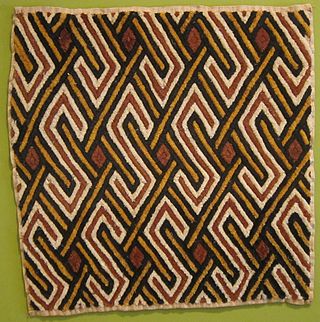
African textiles are textiles from various locations across the African continent. Across Africa, there are many distinctive styles, techniques, dyeing methods, and decorative and functional purposes. These textiles hold cultural significance and also have significance as historical documents of African design.

In embroidery, couching and laid work are techniques in which yarn or other materials are laid across the surface of the ground fabric and fastened in place with small stitches of the same or a different yarn.
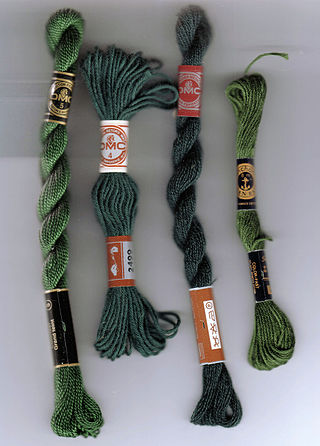
Embroidery thread is yarn that is manufactured or hand-spun specifically for embroidery and other forms of needlework. Embroidery thread often differs widely, coming in many different fiber types, colors and weights.
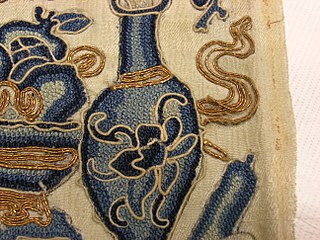
A knotted stitch, also known as knot stitch, is any embroidery technique in which the yarn or thread is knotted around itself. A knotted stitch is a type of decorative embroidery stitches which form three-dimensional knots on the surface of a textile. Common knotted stitches include French knots, coral stitch, and Pekin knot which is sometimes also referred as French knot although there is a difference in techniques between these two stitches. Knotted stitches can be subdivided into individual or detached knots, continuous knotted stitches, and knotted edgings.

Samite was a luxurious and heavy silk fabric worn in the Middle Ages, of a twill-type weave, often including gold or silver thread. The word was derived from Old French samit, from medieval Latin samitum, examitum deriving from the Byzantine Greek ἑξάμιτον hexamiton "six threads", usually interpreted as indicating the use of six yarns in the warp. Samite is still used in ecclesiastical robes, vestments, ornamental fabrics, and interior decoration.

English embroidery includes embroidery worked in England or by English people abroad from Anglo-Saxon times to the present day. The oldest surviving English embroideries include items from the early 10th century preserved in Durham Cathedral and the 11th century Bayeux Tapestry, if it was worked in England. The professional workshops of Medieval England created rich embroidery in metal thread and silk for ecclesiastical and secular uses. This style was called Opus Anglicanum or "English work", and was famous throughout Europe.
Sermeh embroidery, also known as Sormeh embroidery, is an Iranian ancient-style of embroidery. Its origin dates back to the Achaemenid dynasty. It reached its zenith in the Safavid Dynasty. In this style of embroidery, gold and silver threads would be used to make decorating patterns on the surface of fabric; however, nowadays, almost entirely, threads twisted out of cheaper metals and alloys and metal like yarns have replaced gold and silver. The yarn used in patterning is springlike and elastic. Sermeh embroidery is the most popular in the cities of Isfahan, Yazd, Kashan.

Embroidery was an important art in the Islamic world from the beginning of Islam until the Industrial Revolution disrupted traditional ways of life.

Embroidered binding, also referred to as needlework or textile binding, describes a book bound in cloth and decorated with a design on one or both covers and sometimes the spine. The binding is created for the individual book.
Bed hangings or bed curtains are fabric panels that surround a bed; they were used from medieval times through to the 19th century. Bed hangings provided privacy when the master or great bed was in a public room, such as the parlor. They also kept warmth in, and were a way of showing one's wealth. When bedrooms became more common in the mid-1700s, the use of bed hangings diminished.

Colcha embroidery from the southwest United States is a form of surface embroidery that uses wool threads on cotton or linen fabric. During the Spanish Colonial period, the word colcha referred to a densely embroidered wool coverlet. In time, the word also came to refer to the embroidery stitch that was used for these coverlets, and then began to be used on other surfaces. The colcha stitch is self-couched, with threads applied at a 45-degree angle to tie down the stitch. Originally, the wool threads were dyed naturally, using plants or insects, such as cochineal. Both materials used and design motifs have varied over time.
Chinese ornamental gold silk is a type of silk fabric which employs gold as ornamentation; Chinese ornamental gold silk originated in China and have a long history in China. Gold and silk were precious goods; the combination of both in textiles created one of the most valuable commodities. Several gold-ornamental techniques can be summarized as: gold foil, gold powder, and gold thread technique.





